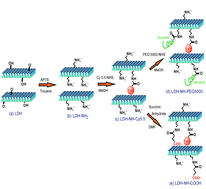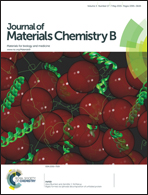Layered double hydroxide nanoparticles to enhance organ-specific targeting and the anti-proliferative effect of cisplatin†
Abstract
To evaluate the role of charge in the nanoparticle distribution we modified the external surface of layered double hydroxide nanoparticles with various organic groups bearing different charges and further a near-infrared (NIR) fluorescent dye (Cy5.5) is conjugated in the layered structure to assess the biodistribution. The functionalized nanocomposites performed as highly efficient contrast agents since Cy5.5 molecule stabilization inside the layered structure can safeguard them from metabolization in the physiological environments. The cell viability, lactate dehydrogenase and hemolytic assays showed no cytotoxicity with an exceptionally low release of both lactate dehydrogenase and hemoglobin from the treated cells. The in vivo biodistribution results disclosed a high accumulation of positive amino-layered double hydroxides (LDHs) in the lungs. In contrast, there is a rapid clearance of negatively charged carboxylate-LDHs from blood flow by liver uptake. Interestingly neutral LDH-PEG5000 showed enhanced blood circulation time, without high fluorescent accumulation in the major organs. In vitro cellular uptake studies from flow cytometry are relevant to the interactions between the nanoparticle surfaces and various cell types and the data are relevant to effects observed for in vivo biodistribution. To further demonstrate that surface functionalization on LDH nanoparticles can promote targeted drug release, we further immobilized hydroxo-substituted cisplatin (CP) on carboxylate-modified LDHs by coordination bonding. Due to the ideal cleaving property of the carboxylate group the coordinated CP can be efficiently released by the increase of acidic proton and Cl− concentration in the endosomal environment. Functionalized LDHs can be successfully employed as targeted drug delivery systems. When the LDH–CP complex accumulate primarily in the targeted organ, the high positive charge on the framework of LDHs cause susceptibility to rapid endocytosis, which facilitates sustained drug release with minimal systemic toxicity providing the apt treatment in the targeted organ.


 Please wait while we load your content...
Please wait while we load your content...